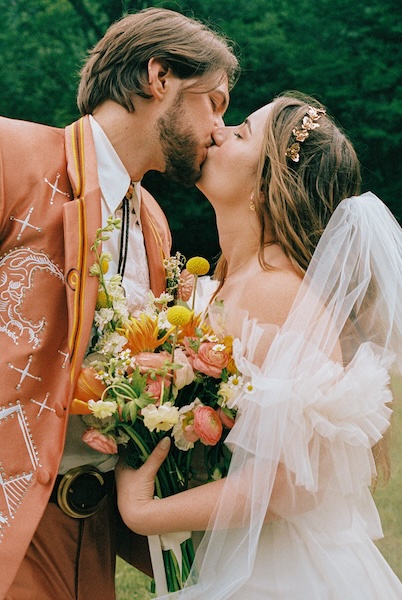A Matter of Time: Craig Varjabedian
January 1, 2010
With vintage lenses and a fresh eye, fine art photographer Craig Varjabedian reveals a deeper truth about New Mexico’s fabled Ghost Ranch.
Craig Varjabedian’s photographs are the kind that sneak up on you. Absent of innovative uses of the latest digital technologies, they don’t announce themselves to viewers with abstract or hyperreal elements but rather are, as the artist himself likes to say, “photographic.” He has even joked that he is “a dinosaur”—a comment that’s misleading. While it’s true that Varjabedian has built his career on using vintage handcrafted lenses and wet darkroom methods to create images aimed more at revealing beauty than undercutting tradition, his work is too authentic to be outmoded and too profound to be trite.
A fine art photographer who has carefully pursued his creative vision for nearly four decades, Varjabedian is, at 52, hitting his stride. His images show a consistent magic that’s made him the subject of filmmaker Karl Kernberger’s Emmy-winning 1991 PBS documentary En Divina Luz (In Divine Light) and earned him the support of the National Endowment for the Arts. Meanwhile, a growing number of cultural pundits, including the late photographer and art historian Beaumont Newhall, have recognized his work as a significant contribution to New Mexico’s already stellar creative legacy.
The secret to Varjabedian’s magic is, in a word, time. It’s the result of the long, slow refinement of a subtle process that combines careful equipment selection (he uses six lenses and 13 Carl Zeiss Protar convertible lens components, all vintage, with a large format 5 x 7-inch Ebony field-view camera) with a commitment to patiently connecting with every subject and a simple but abiding passion for light. In his most recent photographic exhibition and companion book, Ghost Ranch and the Faraway Nearby (displayed at the Albuquerque Museum of Art & History this past fall), the artist takes on a place so fabled that clichés inevitably surround it—and reveals, instead, the elemental energy at its core.
If each place could be said to have a dominant visual theme, at Ghost Ranch it would be color. The single most dramatic feature of the legendary Northern New Mexican retreat’s landscape, immortalized in the paintings of 20th-century artist-resident Georgia O’Keeffe, is its winding band of cliffs in rich shades of red, russet and flame. So it’s unsurprising that the most common question from viewers of Faraway Nearby is why the images were all shot in black and white. “By removing the color, we become more involved with the object’s form and much more aware of the light that’s falling on the object,” says Varjabedian, whose round features and disarming grin belie the intricate drama of his photographs. “Often, a color photograph wouldn’t be faithful to what I saw and felt when I made the image. It always comes back to that.”
With this conviction and the evanescent New Mexico light—famed among artists since the 19th century—at his disposal, Varjabedian is able to wed the photographer’s formal and conceptual considerations. “Here in New Mexico, it almost feels like light is a solid. There are times when I feel like I can literally reach up and catch it, and put it in a Mason jar,” he says. It’s along these same lines that he also discusses a certain ineffable, palpable quality imbued in the space when captured through his Zeiss Protars and other high-end vintage lenses. “It’s almost like stardust,” he muses. In contrast, he explains, “Today’s lenses are incredibly good. Modern lenses are corrected to such a high degree for color that they minimize flare. As a result they can accentuate light’s harsher qualities when used with black-and-white film. Older optics can avoid this trap.” Some of these lenses are 80 years old. And each, he says, has its own personality.
Examining the Protar cells, I’m surprised to see that the imperfections are obvious: There are actually bubbles trapped inside the glass. Yet the reason why Varjabedian would spend decades hunting and swapping these antique optics brings me back to what’s most timely and contemporary about his images: his aesthetic. “I’m not looking for a transcription of reality,” he explains. He does occasionally shoot digitally, if that best achieves a desired effect. “I’m looking for images that feel like it felt when I stood there and that cloud moved over and the light did this. To my mind, that’s what my lenses and film give me.”
Combined with the seemingly impossible amount of detail imprinted on his large format negatives, the result, says Albuquerque Museum director Cathy Wright, is work that’s at once profound and accessible. “There’s something fresh and now about his work, even though it’s really classical,” she says. “People can feel like it’s happening today, and to them, right at this place.”
It’s also part of what makes his work distinct, he suggests, from that of Ansel Adams, to whom he is sometimes compared. “Adams’ images, many of them, were about pristine landscape untouched by human hands. That doesn’t really exist anymore,” says Varjabedian. “I don’t suffer the illusion of a world that’s pristine and perfect. I’m interested in photographing the world I live in—as it comes to me, and as I find it.” What exists now, and in his photographs, is a world in which the marks of human occupation commingle with nature and the land. And this world, if we are to believe the authenticity of his vision, is not without extraordinary beauty. When I ask Wright what appeals to her personally about his images, she says, almost at a loss, “They’re just so beautiful.”
Varjabedian’s life as a photographer began at 5 years old, in Canada’s Banff National Park. On a summer day beside a mountain lake, he held a Kodak Duaflex II given to him by his mother and looked down through the lens at the glacier before him. “Can you imagine?” he asks me as he sits before a case of vintage cameras, carefully holding the one being discussed. “Sitting out there with this little camera, and being absolutely stolen by it. Kidnapped.”
Raised in the automotive-industry town of Windsor, Ontario, and later in the Detroit suburb of Bloomfield Hills, Varjabedian took up photography in earnest at 13, after purchasing a very basic Yashica twin-lens reflex camera with funds earned mowing lawns. Then one afternoon, on a long walk home from a photo shoot for his high school newspaper, he chanced upon a gallery window through which he saw images of a sort he’d never witnessed before: waterfalls, mountains and desert vistas, all epic in scale. Beckoned inside, he went in and met the artist—Ansel Adams. “I want to make photographs like this,” he recalls thinking. “How do I do this?”
That pivotal flash of self-discovery eventually led to two California workshops with Adams, first in Yosemite, and later, after Varjabedian graduated from the University of Michigan, in Carmel. Never shy about approaching experts in nearly every field to plumb their knowledge (as an undergraduate, he regularly “squatted” classes in topics that intrigued him, from philosophy to organic chemistry), the young student pestered the gracious Adams with questions. But perhaps more significantly, it was on a Carmel road trip in 1979 that Varjabedian first passed through New Mexico. Awaking before dawn one morning from where he slept in the back of his car beside Santa Fe’s famous plaza, he watched the sky change and felt deeply that this was where he should be.
Serendipity and coincidence would lead him, over several years, back to New Mexico via the Rochester Institute of Technology in Rochester, NY, where he met photography great Paul Caponigro as a graduate student. Although Caponigro lived just outside of Santa Fe, where Varjabedian moved permanently in 1985 (and where he worked as Caponigro’s studio assistant for two years), the elder photographer had nothing to do with the transplant. Instead, Varjabedian’s chronic health problems related to the winter climate in upstate New York, and a friend who had left New Jersey to take a job in New Mexico conspired to reunite him with the light that so fascinated and inspired him.
It was in New Mexico that he went on to produce roughly 75 percent of his creative work, embarking on exhibition and book projects that mined some deep connection he felt with the region’s spirit, culture and history. First came En Divina Luz: The Penitente Moradas of New Mexico (1994), during which he developed lasting friendships with members of the region’s centuries-old Catholic “Penitente” brotherhood, who shared private information about the locations of their adobe moradas, or meeting houses. That led to the closely related book By the Grace of Light: Images of Faith from Catholic New Mexico (1998), and then Four and Twenty Photographs: Stories from Behind the Lens (2007), an expansive Western portfolio and an inquiry into how an artist’s life and his creativity intertwine. But it would be Ghost Ranch, and the work he produced while alone in its singular landscape, that would fundamentally change his relationship
with imagemaking.
In the preface of his 1983 book of photographs, The Wise Silence, Caponigro wrote, “In my years of photography, I have learned that many things can be sensed, seen, shaped or resolved in a realm of quiet, well in advance of, or between, the actual clicking of shutters… ” Thus came another flash of insight, when Varjabedian recognized in Caponigro a feeling he already sensed within himself. It became the seed of Varjabedian’s “receptive” approach to photography—the decision to unhurriedly explore and settle into the feeling of a subject—to wait for a moment in which it reveals a deeper face to the camera lens. “Once I allowed myself to be available,” he recalls, “then the pictures came and they flowed.”
Ghost Ranch, he is certain, taught him how to do that. For years he had been making visits to the ranch, spending hours at a time walking, watching and waiting, just to be with the space and become open to whatever it might present to him. Then one evening he found himself at a vantage point beneath a peak called Pedernal, which rises to the south of the ranch property, just across the Chama River. It was 1996 and he had been attempting to create images of Ghost Ranch for more than a decade, but none managed to capture the sense of awe that the place itself inspired in him. “If you’re trying to show something that has a pulse,” he says, “like the earth does, like Ghost Ranch does—it’s not always easily perceived. It takes time.”
Now it was sunset and he saw something happening in the clouds over Pedernal—as if “the mountain was orchestrating the sky.” He stopped his car and set up the camera quickly on its tripod, releasing the shutter a handful of times. During one of these times (and only one) the lowering light hit the edge of a cloud and created a shape not unlike a cross. The accent made the composition whole in a way none of the other exposures achieved. He had found something in that moment, and only years later can he say what it was: “I’m trying to allow the subject to speak for itself,” he says. “The veil lifts, and a kind of clarity sets in; that’s what I’m looking for.”
View more of Craig Varjabedian’s photographs at www.craigvarjabedian.com. He offers photography workshops inspired by the beauty of the American West through Eloquent Light Photography Workshops (www.eloquentlight.com).
Marin Sardy wrote the primary essay, “Ghost Ranch: A Place of Sojourns,” in Craig Varjabedian’s new 144-page book of 91 duotone photographs, Ghost Ranch and the Faraway Nearby, published July 2009 by the University of New Mexico Press.




